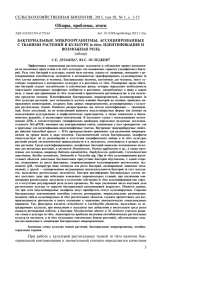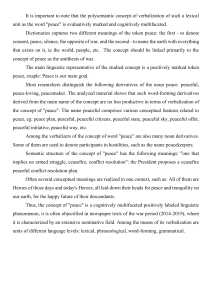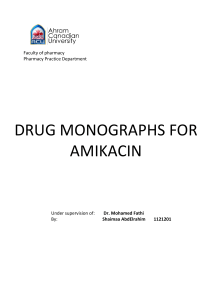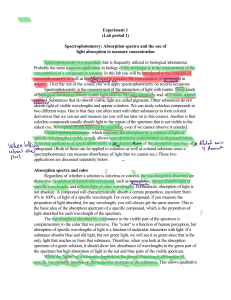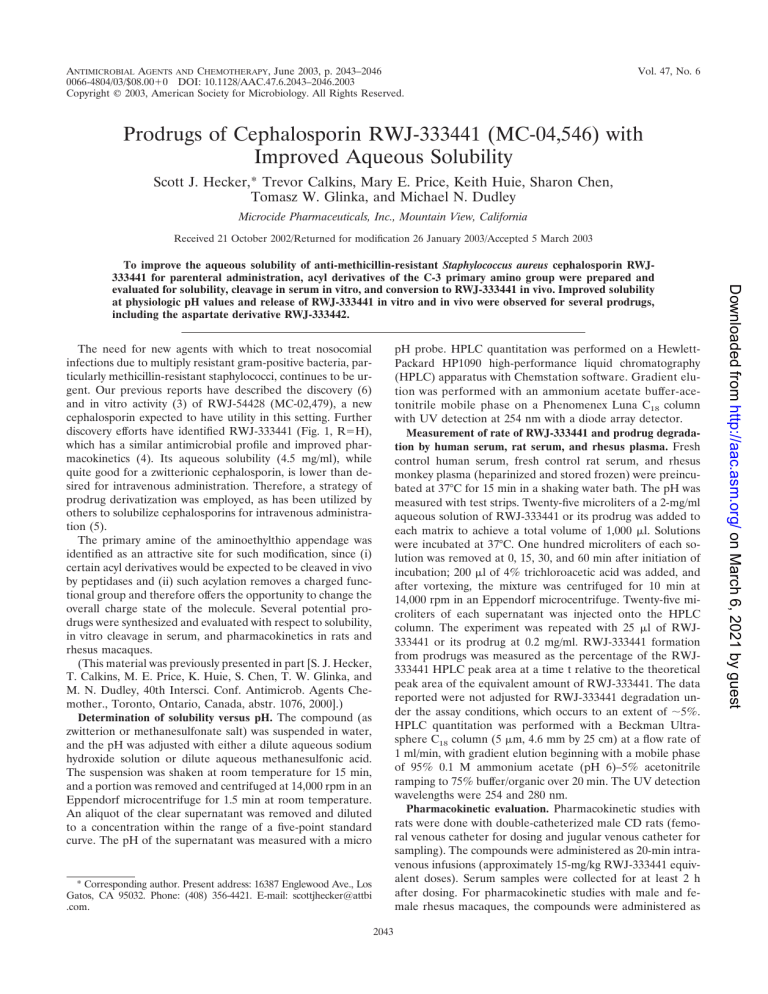
ANTIMICROBIAL AGENTS AND CHEMOTHERAPY, June 2003, p. 2043–2046 0066-4804/03/$08.00⫹0 DOI: 10.1128/AAC.47.6.2043–2046.2003 Copyright © 2003, American Society for Microbiology. All Rights Reserved. Vol. 47, No. 6 Prodrugs of Cephalosporin RWJ-333441 (MC-04,546) with Improved Aqueous Solubility Scott J. Hecker,* Trevor Calkins, Mary E. Price, Keith Huie, Sharon Chen, Tomasz W. Glinka, and Michael N. Dudley Microcide Pharmaceuticals, Inc., Mountain View, California Received 21 October 2002/Returned for modification 26 January 2003/Accepted 5 March 2003 pH probe. HPLC quantitation was performed on a HewlettPackard HP1090 high-performance liquid chromatography (HPLC) apparatus with Chemstation software. Gradient elution was performed with an ammonium acetate buffer-acetonitrile mobile phase on a Phenomenex Luna C18 column with UV detection at 254 nm with a diode array detector. Measurement of rate of RWJ-333441 and prodrug degradation by human serum, rat serum, and rhesus plasma. Fresh control human serum, fresh control rat serum, and rhesus monkey plasma (heparinized and stored frozen) were preincubated at 37°C for 15 min in a shaking water bath. The pH was measured with test strips. Twenty-five microliters of a 2-mg/ml aqueous solution of RWJ-333441 or its prodrug was added to each matrix to achieve a total volume of 1,000 l. Solutions were incubated at 37°C. One hundred microliters of each solution was removed at 0, 15, 30, and 60 min after initiation of incubation; 200 l of 4% trichloroacetic acid was added, and after vortexing, the mixture was centrifuged for 10 min at 14,000 rpm in an Eppendorf microcentrifuge. Twenty-five microliters of each supernatant was injected onto the HPLC column. The experiment was repeated with 25 l of RWJ333441 or its prodrug at 0.2 mg/ml. RWJ-333441 formation from prodrugs was measured as the percentage of the RWJ333441 HPLC peak area at a time t relative to the theoretical peak area of the equivalent amount of RWJ-333441. The data reported were not adjusted for RWJ-333441 degradation under the assay conditions, which occurs to an extent of ⬃5%. HPLC quantitation was performed with a Beckman Ultrasphere C18 column (5 m, 4.6 mm by 25 cm) at a flow rate of 1 ml/min, with gradient elution beginning with a mobile phase of 95% 0.1 M ammonium acetate (pH 6)–5% acetonitrile ramping to 75% buffer/organic over 20 min. The UV detection wavelengths were 254 and 280 nm. Pharmacokinetic evaluation. Pharmacokinetic studies with rats were done with double-catheterized male CD rats (femoral venous catheter for dosing and jugular venous catheter for sampling). The compounds were administered as 20-min intravenous infusions (approximately 15-mg/kg RWJ-333441 equivalent doses). Serum samples were collected for at least 2 h after dosing. For pharmacokinetic studies with male and female rhesus macaques, the compounds were administered as The need for new agents with which to treat nosocomial infections due to multiply resistant gram-positive bacteria, particularly methicillin-resistant staphylococci, continues to be urgent. Our previous reports have described the discovery (6) and in vitro activity (3) of RWJ-54428 (MC-02,479), a new cephalosporin expected to have utility in this setting. Further discovery efforts have identified RWJ-333441 (Fig. 1, R⫽H), which has a similar antimicrobial profile and improved pharmacokinetics (4). Its aqueous solubility (4.5 mg/ml), while quite good for a zwitterionic cephalosporin, is lower than desired for intravenous administration. Therefore, a strategy of prodrug derivatization was employed, as has been utilized by others to solubilize cephalosporins for intravenous administration (5). The primary amine of the aminoethylthio appendage was identified as an attractive site for such modification, since (i) certain acyl derivatives would be expected to be cleaved in vivo by peptidases and (ii) such acylation removes a charged functional group and therefore offers the opportunity to change the overall charge state of the molecule. Several potential prodrugs were synthesized and evaluated with respect to solubility, in vitro cleavage in serum, and pharmacokinetics in rats and rhesus macaques. (This material was previously presented in part [S. J. Hecker, T. Calkins, M. E. Price, K. Huie, S. Chen, T. W. Glinka, and M. N. Dudley, 40th Intersci. Conf. Antimicrob. Agents Chemother., Toronto, Ontario, Canada, abstr. 1076, 2000].) Determination of solubility versus pH. The compound (as zwitterion or methanesulfonate salt) was suspended in water, and the pH was adjusted with either a dilute aqueous sodium hydroxide solution or dilute aqueous methanesulfonic acid. The suspension was shaken at room temperature for 15 min, and a portion was removed and centrifuged at 14,000 rpm in an Eppendorf microcentrifuge for 1.5 min at room temperature. An aliquot of the clear supernatant was removed and diluted to a concentration within the range of a five-point standard curve. The pH of the supernatant was measured with a micro * Corresponding author. Present address: 16387 Englewood Ave., Los Gatos, CA 95032. Phone: (408) 356-4421. E-mail: scottjhecker@attbi .com. 2043 Downloaded from http://aac.asm.org/ on March 6, 2021 by guest To improve the aqueous solubility of anti-methicillin-resistant Staphylococcus aureus cephalosporin RWJ333441 for parenteral administration, acyl derivatives of the C-3 primary amino group were prepared and evaluated for solubility, cleavage in serum in vitro, and conversion to RWJ-333441 in vivo. Improved solubility at physiologic pH values and release of RWJ-333441 in vitro and in vivo were observed for several prodrugs, including the aspartate derivative RWJ-333442. 2044 NOTES ANTIMICROB. AGENTS CHEMOTHER. 30-min intravenous infusions (3- to 8-mg/kg RWJ-333441 equivalent doses). Serum samples were collected up to 8 h after dosing. The parent and prodrug concentrations in serum samples were quantified with the HPLC methods described above for the serum degradation experiments. The lower limit of quantitation was generally 0.5 mg/liter. After administration of RWJ-333441, the serum concentration data were analyzed with a two-compartment model with zero-order input and firstorder elimination from the central compartment (WinNonlin, Pharsight Corp., Mountain View, Calif.). For calculation of RWJ-333441 pharmacokinetic parameters following administration of prodrugs, the prodrug dose was converted to an RWJ-333441 equivalent dose. Noncompartmental pharmacokinetic analysis of RWJ-333441 concentrations in serum was performed with WinNonlin. Synthesis. The preparation of prodrug derivatives is exemplified in Fig. 2 with the synthesis of the aspartyl derivative RWJ-333442 (MC-04,699). Removal of the BOC protecting groups of disulfide 1 (4) and salt exchange produce diamine 2 as the tetrahydrochloride salt. Compound 2 is acylated with FIG. 2. Synthesis of aspartyl prodrug RWJ-333442 (MC-04,699). TFA, trifluoroacetic acid; EtOAc, ethyl acetate; PFP, pentafluorophenyl; BOC, t-butyloxycarbonyl; Tr, trityl; DMF, dimethylformamide. Downloaded from http://aac.asm.org/ on March 6, 2021 by guest FIG. 1. Structures of RWJ-333441 (MC-04,546) and the best prodrug derivatives VOL. 47, 2003 NOTES 2045 protected aspartate pentafluorophenyl ester 3, providing key intermediate 4. In situ reduction of the disulfide and coupling with protected cephalosporin derivative 5 are accomplished with triphenylphosphine in aqueous dimethylformamide. The four acid-labile protecting groups in the product are removed with trifluoroacetic acid-triethylsilane, and the trifluoroacetic acid salt of the product, RWJ-333442, is converted to the zwitterionic form by chromatography on HP20 resin. Solubility of prodrug derivatives of RWJ-333441. The structures of the most successful prodrug derivatives are shown in Fig. 1, and the pH-versus-solubility profiles of some represen- tative prodrugs are illustrated in Fig. 3. The maximum solubilities of all of the prodrug derivatives in the optimal pH range for intravenous administration (pH 4 to 7) are shown in Table 1. RWJ-333441 is very soluble at a low pH (because of protonation of the pyridine nitrogen), whereas the zwitterionic form displays a solubility of 4.5 mg/ml. The shapes of the curves for those derivatives in which the amino acid R group is uncharged are all similar to that of RWJ-333441. Within this set, the type of R group has little effect on the solubility of the zwitterionic form, whether more lipophilic (valine, 6.7 mg/ml), more polar (serine, 7.8 mg/ml), or N substituted (N-methylalanine, 10.3 TABLE 1. Summary of prodrug solubility, in vitro cleavage, and rat pharmacokinetic data Compound or prodrug RWJ-333441 Daloxate Alanyl-alanine Alanine Lysine Aspartate Glutamine Histidine Ornithine Valine Glycine Serine N-Methylalanine Asparagine Proline a Maximum solubility at pH 4–7 4.5 ⬎20 18.1 7.9 ⬎20 ⬎20 7.8 ⬎20 ⬎20 6.7 5.1 7.8 10.3 8.1 6.4 RWJ-333441 AUC (mg 䡠 h/liter) upon prodrug administration (mean % bioavailability)b In vitro formation (%) of RWJ-333441 in serum froma: Human Rhesus macaque Rat 100 84 83 27 23 12 6 6 4 3 3 2 0 0 100 37 82 45 25 100 65 60 23 18 5 2 1 4 0 0 Rat Rhesus macaque 19.8 ⫾ 1.5 (100) 25, 21 (116) 14, 19, 16 (83) 117 ⫾ 35 (100) 31, 19 (127) 90, 137 (97) 43, 83 (54) 77, 139 (93) 10, 14 (61) 7.1, 6.7 (35) 3.4, 5.6 (23) 6.0, 7.6 (34) 0 (0) Following incubation for 60 min at 37°C. Normalized for a 10-mg/kg dose of RWJ-333441; values for RWJ-333441 are the mean ⫾ the standard error of the mean (four animals) and values for prodrugs are for individual animals. b Downloaded from http://aac.asm.org/ on March 6, 2021 by guest FIG. 3. Graph of solubility versus pH for prodrug derivatives of RWJ-333441 (MC-04,546). 2046 NOTES dine, serine); this may be due to peptidase activity in tissues as opposed to serum. A prodrug strategy has been successfully used to improve the solubility of RWJ-333441 for intravenous administration. On the basis of criteria of aqueous solubility, cleavage in vitro in serum, and conversion to the parent drug in vivo, the most promising prodrugs are the aspartate (RWJ-333442), alanylalanine (RWJ-333443), and daloxate derivatives. Further evaluation of prodrug derivatives of RWJ-333441 will be described in a future report. We thank Caitlin Biwersi, Laura Case, Wei Shen, and Vrushali Tembe for technical assistance. This work was conducted as part of a collaboration between Essential Therapeutics and Johnson & Johnson Pharmaceutical Research & Development. REFERENCES 1. Alexander, J., D. S. Bindra, J. D. Glass, M. A. Holahan, M. L. Renyer, G. S. Rork, G. R. Sitko, M. T. Stranieri, R. F. Stupienski, H. Veerapanane, and J. J. Cook. 1996. Investigation of (oxodioxolenyl)methyl carbamates as nonchiral bioreversible prodrug moieties for chiral amines. J. Med. Chem. 39:480–486. 2. Brighty, K. E., and T. D. Gootz. 1997. The chemistry and biological profile of trovafloxacin. J. Antimicrob. Chemother. 39(Suppl. B):1–14. 3. Chamberland, S. C., J. Blais, M. Hoang, C. Dinh, D. Cotter, E. Bond, C. Gannon, C. Park, F. Malouin, and M. N. Dudley. 2001. In vitro activities of RWJ-54428 (MC-02,479) against multiresistant gram-positive bacteria. Antimicrob. Agents Chemother. 45:1422–1430. 4. Glinka, T. W., K. Huie, A. Cho, M. Ludwikow, J. Blais, D. Griffith, S. Hecker, and M. Dudley. 2003. Relationships between structure, antibacterial activity, serum stability, pharmacokinetics and efficacy in 3-(heteroarylthio)cephems. Discovery of RWJ-333441 (MC-04,546). Bioorg. Med. Chem. 11:591–600. 5. Hebeisen, P., I. Heinze-Krauss, P. Angehrn, P. Hohl, M. G. P. Page, and R. L. Then. 2001. In vitro and in vivo properties of Ro 63–9141, a novel broadspectrum cephalosporin with activity against methicillin-resistant staphylococci. Antimicrob. Agents Chemother. 45:825–836. 6. Hecker, S. J., T. W. Glinka, A. Cho, Z. J. Zhang, M. E. Price, S. Chamberland, D. Griffith, and V. J. Lee. 2000. Discovery of RWJ-54428 (MC-02,479), a new cephalosporin active against resistant gram-positive bacteria. J. Antibiot. 53: 1272–1281. Downloaded from http://aac.asm.org/ on March 6, 2021 by guest mg/ml). A notable exception is the alanyl-alanine prodrug (18.1 mg/ml), whose superior solubility has a precedent in the corresponding parenteral prodrug (alatrofloxacin) of the fluoroquinolone antibacterial trovafloxacin (2). The solubility curve of the L-aspartyl derivative has a very different shape because of an additional ionizable group, with a solubility of ⬎50 mg/ml at pH ⬎4.5. Three amino acid derivatives containing an additional positively charged group (lysine, ornithine, and histidine) and a daloxate prodrug (Fig. 1) display a solubility of ⬎20 mg/ml over a pH range of 3 to 7. Prodrug cleavage in vitro. Formation of parent drug RWJ333441 from various prodrugs in vitro in rat, rhesus macaque, and human sera (37°C, 1 h.) is shown in Table 1. The alanine derivative appeared to be a particularly good substrate for peptidases in human serum; of the prodrugs based on amino acids, the alanine (83% formation of RWJ-333441 in 1 h) and alanyl-alanine (84%) derivatives were cleaved most completely. An intermediate extent of formation of RWJ-333441 was observed with the aspartate (23%) and lysine (27%) prodrugs; all other amino acid derivatives were cleaved to a lesser extent. The daloxate derivative, which is cleaved by serum esterases (1), is converted rapidly and quantitatively to the parent drug. No significant difference between species in the extent of cleavage was observed. RWJ-333441 formation in vivo. Prodrugs selected on the basis of solubility and serum cleavage data were administered to rats and rhesus macaques for assessment of conversion to the parent drug RWJ-333441 (Table 1). Of the prodrugs evaluated, the highest conversion to RWJ-333441 was observed with the aspartate (RWJ-333442), alanyl-alanine (RWJ-333443), and daloxate prodrugs. It is interesting that some prodrugs displaying slow conversion in vitro showed moderate conversion to the parent compound in vivo (ornithine, glycine, histi- ANTIMICROB. AGENTS CHEMOTHER.
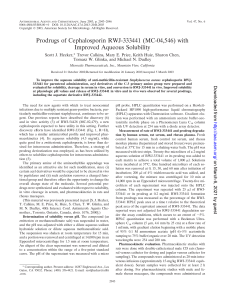
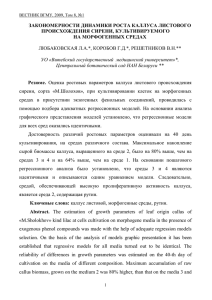
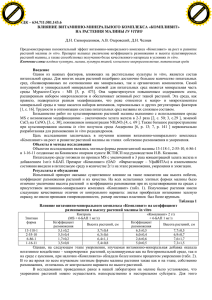
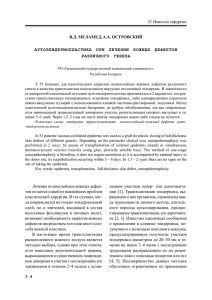
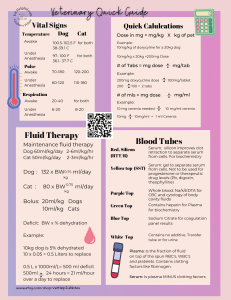
![ISSN 1561-6274. Нефрология. 2009. Том 13. №3. © Ì.Ì.Âîëêîâ, 2009 ÓÄÊ 616.61-036.12-008.9]:546.41+546.18](http://s1.studylib.ru/store/data/002088276_1-4bc2ed86dc4c87a6d852f5029de422b0-300x300.png)
